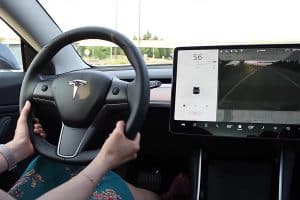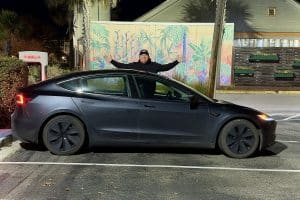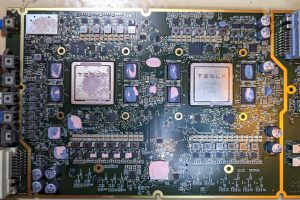- 🚗 Tesla has fixed a four-year-old Full Self-Driving (FSD) visualization bug, improving the smoothness of its semi-autonomous driving feature.
- 🔄 Previous visualizations were affected by jittery movements, creating inaccurate representations of nearby vehicles.
- 👨💻 Ashok Elluswamy, Director of Tesla’s Autopilot Software, confirmed the fix replaced over 300,000 lines of C++ code in FSD version 12.5.6.
- 🎨 FSD visualization plays a critical role in illustrating surroundings like vehicles and pedestrians, enhancing the overall self-driving suite.
- ⚡ The improvement is minor but significant, removing distracting visual glitches on the screen.
- 🎬 Tesla’s focus is shifting to the upcoming Robotaxi unveiling event at Warner Bros. Studios.
Tesla has been making waves in the automotive industry, consistently driving innovation forward with its cutting-edge technologies. One of the most recent developments is the resolution of a longstanding bug in Tesla’s Full Self-Driving (FSD) visualization system. This significant improvement not only enhances the overall driving experience but also sets the stage for Tesla’s next big announcement: the Robotaxi unveiling. Let’s dive into the implications of these changes and explore what they mean for Tesla and its users.
The Four-Year-Old Bug in Tesla’s FSD Visualization
For years, Tesla owners utilizing the Full Self-Driving feature have noticed an occasional ‘jittery’ behavior in the visualization of surrounding vehicles. This inconsistency led to vehicles appearing to vibrate or make unrealistic movements on-screen, which distracted users from a seamless experience. The visualization is a vital component of Tesla’s semi-autonomous driving, designed to reflect real-time environment dynamics accurately.
The Technical Fix: A Deep Dive
Ashok Elluswamy, the Director of Tesla’s Autopilot Software, announced a fix to this problem that replaced over 300,000 lines of explicit C++ code with the new FSD version 12.5.6. But what do these changes entail?
Key Updates in FSD Version 12.5.6
- Code Overhaul: The extensive rewrite of the C++ code has fundamentally changed the underlying architecture, making the system more efficient and reactive.
- Improved Visualization Stabilization: This update ensures that the representations of surrounding vehicles and other objects on the road are smoother and more stable, providing drivers with a clearer understanding of their immediate environment.
- Increased System Reliability: With these updates, Tesla’s FSD system is not only more reliable but also better equipped to handle complex traffic scenarios, boosting user confidence.
Enhancing the Driving Experience with FSD Visualization
Tesla’s FSD visualization is central to its self-driving suite, providing an intuitive display of nearby vehicles, pedestrians, and other essential road elements. Here’s how the improved visualization boosts the driving experience:
- Enhanced Awareness: By giving a more accurate depiction of the surroundings, drivers can maintain better situational awareness.
- Reduced Driver Fatigue: A smoother display reduces cognitive load and stress, enabling drivers to focus on critical driving tasks.
- Safety Improvements: Accurate visual cues enhance decision-making, thereby increasing overall safety for both the driver and pedestrians.
Looking Forward: Tesla’s Upcoming Robotaxi Event
As Tesla rectifies past anomalies, it simultaneously gears up for the future. The upcoming Robotaxi unveiling at Warner Bros. Studios marks another radical shift for the brand. Here’s what we can anticipate from this event:
What’s on the Horizon?
- A New Autonomous Era: The Robotaxi represents Tesla’s vision of a fully autonomous vehicle fleet that could potentially transform urban mobility.
- Potential Enhancements: Expect a focus on hardware and software integrations that support this new venture, possibly borrowing elements from the recent FSD improvements.
- Market Implications: The Robotaxi may redefine how we view public and on-demand transportation, potentially leading to shifts in urban planning and legislation.
Concluding Thoughts
Tesla’s continuous advancement in self-driving technology is a testament to its innovation-centric culture. By rectifying a crucial issue in its FSD visualization, Tesla not only improves the immediate driving experience but also paves the way for future innovations like the Robotaxi. As consumers, these developments provide exciting prospects in autonomous driving, making driving smarter, safer, and more enjoyable.





